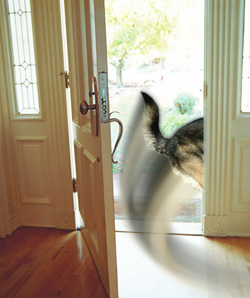Dog Escapes
Runaway Dog
 Backyard escape artists love to figure out ways to break out of their yard, employing all kinds of mental acuity to dig, tunnel or climb to freedom. Dogs that bolt through the front door, however, seem motivated by a different drive – the thrill of the chase. There’s nothing that compares to a heady game of “Chase me!” through traffic, leaving dogs exhilarated and owners terrified to open their own front door for fear of a runaway dog.
Backyard escape artists love to figure out ways to break out of their yard, employing all kinds of mental acuity to dig, tunnel or climb to freedom. Dogs that bolt through the front door, however, seem motivated by a different drive – the thrill of the chase. There’s nothing that compares to a heady game of “Chase me!” through traffic, leaving dogs exhilarated and owners terrified to open their own front door for fear of a runaway dog.
The problem is particularly problematic around the holidays, when guests and delivery men descend on the front steps with increasing frequency. How do you break your dog of this bad habit – and of the terrible anxiety when your dog runs away?
Dog Runs Out Door
Traditionally, dog trainers have resorted to all kinds of booby-traps to squelch this behavior, such as launching noisemaking or startle devices at the dog, or tying the dog on a long line of just the right length so that he’s stopped in his tracks (and usually flipped over) when he hits the end of the rope.
These methods work by teaching the dog that hurrying through the front door causes pain, essentially creating an artificial phobia in the dog, should he dare venture forth. The problem with this kind of training is that for nervous dogs it can deepen anxiety problems and for particularly bold pooches, it can have absolutely no effect whatsoever. Plus, the timing on the human end has to be completely precise, or it doesn’t stop dog escapes at all.
Boundary Stay
A much more effective way of dealing with a bolting dog is to teach a boundary stay. This basically means that your dog will understand that he may not cross the threshold of the door without your permission – usually a release word such as “Okay!” Boundary stays are particularly effective for multi-dog households, where guests arriving can cause even more chaos near the door.
To teach this, the first thing you’ll have to do is leash up your dog prior to any arrival or door-opening. If your dog gets really excited by his leash, it’s not a bad idea to let your dog start wearing one of two training devices: a drag line (sometimes called a house line) or a tab leash. A drag line is simply a very lightweight line between four and ten feet long that is attached to your dog’s normal collar. There is no loop at the end, so that it won’t get caught on objects in your home, and the dog wears this while you’re home, allowing you to step on the line and immediately get control of your dog by effectively “leashing” him when needed. A tab collar works the same way, except that a tab is usually between six and eighteen inches long, and essentially allows you to grab your dog’s collar without having to grapple with him – particularly helpful for dogs with long coats.
Once you’ve set yourself up with a leash system, you’ll start requiring your dog to hold either a sit or down stay when you open the front door. Begin practicing this without any guests, opening and closing the door, and re-setting your dog in the stay position (using the leash if necessary) if he breaks. Never allow your dog to go through the door without your “Okay!” command.
Begin moving around near the door, opening it, shutting it, stepping outside and coming back in before trying it with distractions like guests. Your routine should be the same every time: approach the door, sit your dog, then open the door and pay the pizza guy. If your dog breaks, immediately deal with your dog first, even if it means making guests wait while you regain control. Close the front door if necessary; most people will understand. No one wants to see a runaway dog.
If you have a rug at your entry, you can even teach the boundary stay on the rug, and not the threshold, which will give you a bit of a buffer should your dog break the stay. This also works well for dogs that get too wiggly at the front door with guests and is great if you have more than one dog in the house. Remember, during this training phase, your focus should always be on the dog, not the door, until you have a really rock-solid stay.
Consistency is Key
It’s important that everyone in the house understand the drill, because consistency is the only way to reinforce this behavior. If your dog must sit and stay every time the door is opened, he’ll soon learn that bolting isn’t allowed anymore. However, this requires that all humans in the house all follow the exact same routine, which is sometimes more of a challenge than just training the dog.
But the reward is enormous. If your dog runs away or escapes out the door, your entire household will be in a state of panic. By practicing these techniques with consistency and a concerted effort, the days of chasing your dog through traffic can be over, which will allow your dog – and you – to enjoy a safer and happier life together.

